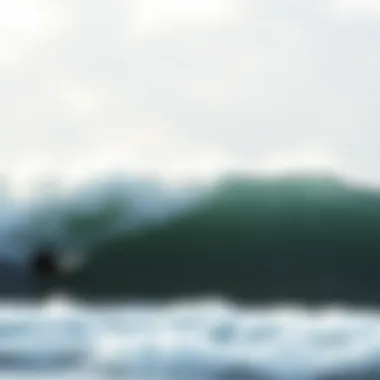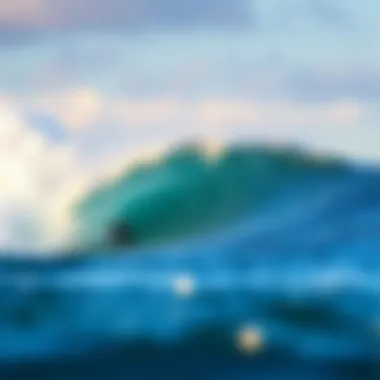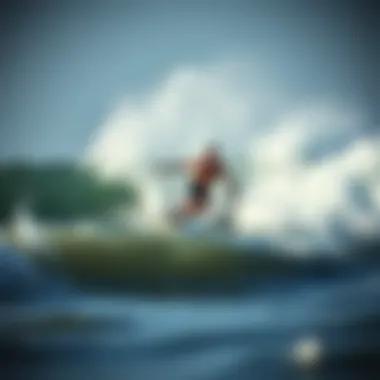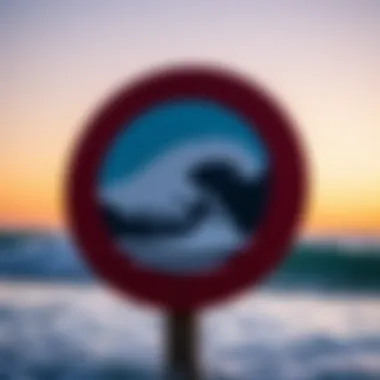Understanding Wind Wave Forecasts for Surfers


Intro
Surfing is not just a sport; it's a lifestyle intertwined with nature's rhythm. Understanding wind wave forecasts is crucial for both beginners and seasoned surfers looking to ride the swells. Waves don't just pop up from nowhere; they're intricately linked to weather patterns, wind speeds, and ocean currents. This article digs into the whys and hows of wind wave forecasts which significantly affect surfing experiences. By exploring various methodologies and the technologies in play, we aim to arm surfers with the knowledge they need for better safety, enjoyment, and environmental consciousness.
Surf Gear and Equipment
Latest Surfboard Technologies
In today’s surfing realm, the advancements in surfboard technology have been nothing short of revolutionary. From epoxy materials to computer-generated designs, the latest boards are engineered for performance and durability. High-performance surfboards utilize carbon fiber for a lightweight but robust construction, allowing surfers to gain and maintain speed effortlessly.
Moreover, designs like soft-top boards have made waves (pun intended) in the surf arena. They offer a softer landing and decreased risk of injury, making them perfect for novice surfers. More experienced riders, however, are leaning toward high-performance thrusters that provide swift maneuvers on those challenging waves. Understanding which surfboard complements both skill level and wave conditions can make all the difference.
Essential Accessories for Surfers
Alongside a sturdy board, having the right accessories can greatly enhance the surfing experience. Some necessary essentials include:
- Wetsuits: Critical for temperature regulation; these come in various thicknesses to suit different water temps.
- Leashes: Often underestimated, a good leash keeps surfers connected to their board, avoiding unwanted accidents in the water.
- Wax: Applying wax correctly can mean the difference between slipping off the board and sticking to it seamlessly.
- Board Bags: Protecting your investment from nicks and scratches is vital, especially for surfers traveling to different beaches.
"When you're well-equipped, there's no limitation to the waves you can conquer."
Safety and Surf Etiquette
Surfing, as thrilling as it is, comes with its own set of risks. Understanding surf etiquette is essential to ensure everyone has a good time while minimizing accidents. Key points to keep in mind include:
- Right of Way: Always remember that the surfer closest to the peak of the wave has priority.
- Communication: If you're heading out with friends, use hand signals. A simple wave or shout can indicate your next move.
- Respect the Locals: Many surf spots have an unspoken set of rules to protect the community. Being courteous can earn you respect and a safer experience.
Developing techniques and skills tailored to various conditions can lead to improved performance on the waves, but safety should always take precedence. Being aware of current weather conditions through accurate forecasts and understanding the equipment at one's disposal can mitigate risks.
Techniques and Skills
Wave Riding Strategies
Mastering wave riding is much like learning a dance; timing, positioning, and skill play roles in synchronizing with the waves. Here are several key strategies:
- Paddling Technique: Effective paddling helps you gain momentum, positioning you to catch the wave when it arrives.
- Body Positioning: Keep low for better control and balance. Shifting weight helps in turns and riding out the wave steadily.
- Reading Waves: Interpreting the waves’ behavior ahead of time is crucial. Watching how they break can inform you of the best angle to catch them.
Environmental Awareness
With the rise in popularity of surfing, environmental considerations cannot be overlooked. Surfers are often the first to notice changes in water quality and marine life. Understanding the delicate balance of ocean ecosystems is vital, not only for personal enjoyment but also for the heritage of surfing itself. Being proactive means:
- Engaging in beach clean-ups.
- Supporting sustainable practices in local surf shops.
- Educating fellow surfers on respecting marine life.
In summary, developing a deep understanding of wind wave forecasts and how they relate to various forms of surfing practice—from the equipment we use to the ethics we uphold—is fundamental. For surfers, the ocean is a playground, and while we seek thrills, we must also remain stewards of the very environment we cherish. Those who ride the waves not only for enjoyment but also with respect for nature will ultimately find the most enriching experiences.
Understanding Wind Waves
In the world of oceanography and surfing enthusiasts, understanding wind waves is paramount. These waves not only define the quality and safety of surf conditions but also are instrumental in various environmental assessments. When surfers hit the beach, they are not just looking for any old swell; they are seeking the right type of wind waves that align with their skill level and preferences.
Wind waves arise from the interaction of wind with the ocean surface, influenced by several factors, which we will explore in detail. Recognizing these factors helps surfers anticipate wave behavior and make informed decisions about when and where to surf. Moreover, the dynamics of wind waves can also serve as an indicator of changing weather patterns, giving surfers and coastal communities valuable foresight, especially in a world where climate change plays an ever-increasing role.
This section will first define what wind waves are, diving into their particular formation processes. We will then categorize the various types of waves that arise, emphasizing their characteristics and importance to surfing and broader ecological contexts.
Definition of Wind Waves
Wind waves, simply put, are the surface waves formed by the friction of wind blowing across the ocean. They can vary greatly in size and energy, influenced by several conditions such as wind speed, duration of wind exposure, and the distance over which the wind blows—referred to as fetch.
Understanding these fundamental definitions sets the groundwork for comprehending more complex behaviors of these waves. As surfers, having a grasp of what constitutes a wind wave enables us to better predict conditions and find the best spots to enjoy the sport.
Formation Process
The generation of wind waves involves several key factors:
Atmospheric Conditions
Atmospheric conditions play a critical role in forming wind waves. The wind’s speed and direction are significantly influenced by atmospheric pressure systems and temperature variations. High-pressure systems, typically associated with clear skies, can generate consistent winds, leading to uniform wave formation. Meanwhile, low-pressure systems can create turbulent conditions, adversely affecting wave quality.
One unique feature of atmospheric influence is how it interacts with regional geography; coastal areas may experience different wind patterns due to mountain ranges or urban structures. This geographical influence can either enhance or disrupt wind wave formation, creating localized wave patterns that surfers must be keen to recognize.
Wind Patterns
Wind patterns are essential for understanding how wind waves develop. The pattern can be gusty, steady, or vary dramatically with time and season. The key characteristic of wind patterns is consistency; in areas where the wind blows consistently from one direction, the resulting waves tend to have a stronger and more organized form, making them ideal for surfing.
An advantage of understanding wind patterns means enthusiasts can better predict surf conditions. However, an issue arises in examining unpredictable, swirling winds which can create chaotic and unsurfable waves. Surfers benefit greatly from tracking local wind patterns to maximize their riding conditions.
Fetch and Duration
Fetch refers to the distance over which wind travels across open water without obstruction. The longer the fetch, the more energy waves can gather, leading to larger and more powerful waves. Duration also matters; sustained winds lead to more significant wave energy accumulation.
Unique features of fetch are often overlooked by casual surfers. In fact, a short fetch can produce choppy waves that are less predictable, making it difficult for surfers to navigate. On the other hand, a well-established fetch with consistent wind can lead to ideal conditions for various skill levels, making it crucial for wave riders to consider.
Types of Waves
Understanding the different types of waves is just as important as grasping their formation processes.
Capillary Waves
Capillary waves are the smallest waves created primarily by light winds. They appear as tiny ripples on the water surface. Although they are not ideal for surfing, they represent the initial stage of wave development. Their characteristic quickness to dissipate can be seen as a disadvantage, but they often precede larger waves that provide more surfing potential.
Gravity Waves
Gravity waves are formed when the wind blows consistently over a long fetch. These are the waves most familiar to surfers, having heights and lengths that facilitate a range of surfing experiences. What sets gravity waves apart is their ability to maintain energy over longer distances, ensuring quality surf conditions persist until they reach the shore. However, they can also be deceptive, varying drastically depending on local conditions.


Swell Waves
Swell waves are a step up from gravity waves when they’re produced from distant storms. These waves travel vast distances and maintain energy and shape for longer periods. A significant characteristic of swells is their predictability; experienced surfers often track swells to find the best conditions for encouraging rides. Nonetheless, swells can also lead to challenging conditions if combined with adverse wind.
Understanding wind waves and their characteristics is crucial for anyone who wishes to enjoy and respect the ocean. With proper knowledge, individuals can harness the energy of these waves, ensuring a thrilling yet safe experience on the water.
The Significance of Wind Wave Forecasts
Wind wave forecasts are crucial for those who engage with the ocean, be it for surfing, fishing, or simply enjoying the beach. Understanding them helps in predicting not only the size and quality of waves but also the associated risks and safety considerations. In this part, we will delve into how wave forecasts shape surfing conditions as well as how they impact safety on the water.
Impact on Surf Conditions
Waves Size and Quality
The size and quality of waves are fundamental aspects that surfers consider when hitting the water. Large, powerful waves can provide exhilarating rides, but they can also come with risks. A quality wave, as any surfer would tell you, is not just about size; it is about shape and consistency too. When a forecast predicts sizable swells, it usually means that surfers can expect a thrilling experience. However, there’s a catch. Waves that are too big or choppy can create hazardous conditions.
For instance, during swell generated by storms far off the coast, the energy transfer can produce waves that are both thrilling and intimidating. Surfers often look for forecasts that indicate not just height but also the wave's period—the interval between waves. A longer period means more organized, rideable waves, making it a popular choice for surf forecasts. Here’s what to remember:
- Height and Power: Bigger waves can be more powerful, leading to better rides.
- Shape and Form: A well-shaped wave is key for a quality surfing experience.
- Predictability: Consistent waves often mean a better surfing session.
But it’s not all smooth sailing, and that’s why understanding the wave forecast is vital.
Tides and Currents
Beyond wave size, tides and currents have a substantial effect on how waves break and the overall conditions at the beach. Surfers often keep a close eye on tide charts when planning a trip, as different tides can expose or obscure sandbars that create ideal waves. It’s like a chess game, where every move counts.
As the tide moves in or out, the way waves interact with the shoreline shifts dramatically. High tide could bring softer, slower waves, perfect for beginners, while low tide might lead to faster, more aggressive waves that challenge even seasoned surfers.
- Tidal Fluctuation: Tides can either enhance or destroy wave quality, depending on their timing with the swell.
- Currents: Understanding currents can be crucial for safety, as they can pull surfers in unintended directions, even leading into dangerous areas.
- Experience Level: Tides can dictate the type of waves available, catering to different surfer skill levels.
Thus, the interplay of waves and tides is pivotal in forecasting their conditions, influencing when surfers will find optimal waves and how safe they feel doing so.
Safety Considerations
Safety is an integral part of any discussion about wind wave forecasts. Quality forecasts can protect surfers from the perilous aspects of nature’s force.
Hazardous Conditions
Hazardous conditions may include strong rip currents, large breaking waves, or adverse weather—elements often included in wind wave forecasts. When these are predicted, they serve as red flags. Surfing in such environments can be beyond risky, it can be life-threatening.
Advisories and warnings are essential because they guide surfers to make informed decisions.
- Rip Currents: These fast-moving channels of water can catch even the strongest swimmer off guard.
- Wave Heights: A sudden increase in wave height can indicate the arrival of a storm swell, heightening risks.
- Weather Impacts: Wind not only affects wave size but can also create a chaotic ocean environment slowing down response times.
Forecasts that emphasize these dangers prevent surfers from heading into conditions they aren’t equipped to handle, safeguarding lives.
Weather Patterns
Lastly, understanding weather patterns is vital for accurate wind wave forecasting. Different weather systems can churn up waves and currents, impacting how they behave. For example, storms can produce large, erratic waves, which are often accompanied by winds that result in choppy water, making it difficult for surfers to perform.
Additionally, changes in air temperature and pressure can signal shifts in wave energy, allowing surfers to anticipate better or worse conditions.
- Weather Systems: Low and high-pressure areas affect local wind conditions and wave performances.
- Seasonal Changes: Certain times of the year may bring in different patterns, such as hurricanes that can drastically change local wave dynamics.
- Forecast Integration: Combining wave forecasts with weather patterns can provide a holistic view of conditions, maximizing safety and enjoyment.
Understanding wind wave forecasts isn’t merely about figuring out the best time to catch a wave; it encompasses safety, enjoyment, and environmental respect that keeps surfers coming back for more, year after year. With thoughtful interpretation of these factors, surfers can elevate their experience while navigating the unpredictable ocean with a level of awareness that foresees potential pitfalls and seizes every swell.
Forecasting Methodologies
Understanding the methodologies of forecasting wind waves is crucial for anyone involved in surfing or coastal activities. These methods not only provide insights into expected wave conditions but also ensure safety and preparedness. By diving deep into various approaches, we can appreciate how these forecasts are constructed and improve our overall surfing experience.
Numerical Weather Prediction Models
Model Types
Numerical Weather Prediction (NWP) models are a cornerstone of modern meteorology. They use mathematical equations to simulate the atmosphere's behavior, factoring in various meteorological elements such as pressure, temperature, and wind speed.
A key characteristic of NWP models is their reliance on vast computational resources, which enable them to process and analyze complex datasets. This makes them a go-to choice for predicting conditions like wind waves, as they can simulate different scenarios based on changing environmental inputs.
One unique feature of these models is their ability to reflect real-time updates, incorporating current weather data to refine forecasts. This can be beneficial because it enhances accuracy when conditions shift unexpectedly. However, the downside is that these models can also produce discrepancies, particularly in local areas with microclimates that don't conform to general patterns.
Data Input Requirements
Data input requirements for NWP models are extensive. They draw from numerous sources, including satellite imagery, surface observations, and buoy data.
This characteristic allows for a comprehensive understanding of the atmosphere, and it's a popular choice because it merges historical data with the latest readings. The integration of such varied datasets increases the reliability of forecasts, as it covers a broader range of possible influences on wave formation.
A unique aspect of data input is its need for accuracy. Poor quality or incomplete data can lead to significant forecasting errors. In that sense, while robust data intake enhances forecast resilience, it also makes the models vulnerable to these outside variables that can affect outcomes.
Statistical Forecasting
Historical Data Analysis
Historical data analysis plays a pivotal role in statistical forecasting. By examining past wave conditions and weather patterns, forecasters can identify trends that help predict future events.
The key feature of this method lies in its ability to use long-term records, which makes it a valuable tool for understanding patterns not readily apparent in real-time data. This deep dive into history allows surfers to anticipate water conditions based on past wave behavior.
A unique aspect of historical data analysis is its capacity to reveal anomalies or patterns that may not repeat in shorter time frames. While it's often beneficial, it may also be limited by the variability nature brings; relying too much on historical trends may overlook exceptional circumstances that deviate from the norm.
Pattern Recognition
Pattern recognition involves using algorithms to understand and predict wave conditions based on identified historical trends. In the context of wind wave forecasting, this method can streamline data processing and enhance efficiency.


Its hallmark is the speed at which it can analyze vast datasets, making it a popular choice among researchers and surf enthusiasts alike. By spotting wave patterns, surfers can better gauge when and where to ride.
One unique advantage of pattern recognition is its adaptability; as new data flows in, algorithms can refine their predictions, making this approach dynamic. On the flip side, however, over-reliance on algorithmic predictions may lead to missed insights that experiential knowledge could provide, highlighting a gap between technological advancement and human intuition.
"Forecasting waves isn't just about numbers; it’s about understanding the dance between wind, water, and time."
The End
In the world of wind wave forecasting, employing the right methodologies is essential for creating accurate and beneficial forecasts. Both numerical weather prediction models and statistical forecasting techniques provide distinct advantages, allowing surfers and coastal communities to harness the power of data for more informed decisions. As these approaches evolve, they herald a future where understanding wind waves could mean the difference between a thrilling surf session and a perilous situation.
Technological Advancements in Forecasting
In the world of wind wave forecasting, technology plays a pivotal role in enhancing the accuracy and reliability of predictions. With advancements rapidly transforming the methodologies used, surfers and researchers alike can gain precise insights into wave conditions, timely making it much easier to plan recreational activities or scientific studies. A closer look reveals how satellite technology and wave buoys have become indispensable tools in forecasting.
Satellite Technology
Remote Sensing
Remote sensing is an integral aspect of satellite technology, allowing for the collection of data from a distance, typically using satellites orbiting the Earth. What makes remote sensing stand out is its capability to gather vast amounts of information regarding wind patterns, sea temperature, and wave heights without any physical contact. This characteristic renders remote sensing a popular choice in modern forecasting practices.
One unique feature of remote sensing is the ability to cover large bodies of water in a relatively short span of time. This rapid data collection is crucial for accurately tracking storm developments and changing conditions at sea. However, while remote sensing has its advantages, such as broad spatial coverage, it also has some disadvantages. For instance, factors like cloud cover or atmospheric disturbances can hinder data accuracy, making it sometimes unreliable. Nevertheless, when combined with other forecasting methods, remote sensing greatly enriches the datasets available for wave predictions.
Image Processing Techniques
Image processing techniques involve analyzing and transforming images acquired from satellite systems to extract valuable information regarding oceanic conditions. This process holds significance as it allows geoscientists to interpret the changes in wave morphology and recognize patterns in wave formation. A key characteristic of image processing is the enhancement of visual images, which enables better detection of subtle changes in wave behavior.
One notable feature is the application of algorithms that can automate the analysis process, considerably reducing human error and increasing efficiency. Image processing offers the benefit of visual clarity, helping forecasters distinguish between different wave types and conditions. On the downside, the complexity of these techniques can sometimes lead to interpretation challenges, particularly when dealing with dynamic ocean conditions. The need for skilled analysts is vital for ensuring the generated insights are accurate and actionable.
Wave Buoys and Sensors
Real-Time Data Collection
Real-time data collection through wave buoys is a game changer in the realm of wind wave forecasts. These buoys are equipped with advanced sensors that gather precise data on wave height, period, and wind speed continuously. A standout feature here is the immediacy of data, allowing surfers and researchers to access updates on conditions as they unfold.
The advantage of real-time data collection is the timely nature of the information, which is critical for decision-making. Surfers can adjust their plans based on the most accurate and current data. However, operating wave buoys comes with its challenges. For example, harsh marine environments can compromise the buoy's functionality, leading to gaps in data collection. Regular maintenance and checks are essential to ensure optimal performance of these devices.
Data Transmission Challenges
Data transmission challenges are inherent when operating wave buoys and sensors. The collection of real-time data is only beneficial if it can be transmitted effectively to users. Factors such as distance from shore, bandwidth limitations, and interference from environmental elements can significantly hinder data transmission. A key characteristic of this challenge is the reliance on satellite or radio transmission methods, each with their own limitations.
Despite these challenges, advancements in communication technology are helping to ameliorate this issue. The ability to send data quickly and with reduced lag time enhances the overall forecasting model. However, solutions can come at a cost, requiring investment in equipment and maintenance. Thus, while the potential for seamless data transmission exists, the feasibility of implementing such systems largely depends on available resources.
Evaluating Forecast Accuracy
Assessing the reliability of wind wave forecasts is crucial for surfers and maritime activities. The precision of these forecasts not only informs surfers of upcoming conditions but also aids in ensuring safety and environmental protection. Quantifying forecast accuracy involves methodologies that yield insights into how well predicted values align with actual conditions. Understanding these metrics helps normalize forecasting processes, enhancing trust in the data provided to users.
Metrics of Accuracy
Bias Analysis
Bias analysis focuses on evaluating the consistency of forecasts over time. Essentially, it assesses whether predictions tend to overshoot or undershoot actual wave heights. This analysis is beneficial as it provides a clear picture of systematic errors in forecasting. A key characteristic of bias analysis is its ability to highlight recurring trends, offering valuable insights into forecast reliability. By doing so, it enables forecasters to adjust their predictions to better reflect actual wave conditions.
The unique feature of bias analysis is its straightforward comparative approach. It examines the difference between predicted and observed wave heights, revealing patterns that could go unnoticed otherwise. However, a downside might be the potential for misleading conclusions if only a narrow timeframe is examined. Therefore, incorporating a broader dataset is essential for reliable assessments.
Skill Score Calculation
Skill score calculation measures a forecast’s performance relative to a baseline, such as climatology or persistence forecasts. This metric is essential as it provides a standardized approach to evaluating predictions, making it easier to understand how effective a forecasting model is. A key characteristic of skill score calculation is its ability to encapsulate improvements or declines in predictive performance, facilitating the comparison of different forecasting models.
What sets this metric apart is its adaptability to various forecasting scenarios. It can reflect the nuances present in wind wave patterns, offering a nuanced understanding of a model's predictive capabilities. However, one limitation might be the dependence on carefully selected baseline forecasts. If the baseline doesn't represent actual conditions well, it can lead to misleading skill assessments.
Common Errors in Predictions
Overestimation of Wave Heights
One prevalent issue in forecasting is the overestimation of wave heights. This typically occurs due to miscalculations in underlying atmospheric conditions, leading to inflated predictions. Understanding this phenomenon is critical because it can affect preparation and safety measures for surfers. If forecasts consistently overestimate wave heights, it can instill a false sense of security among surfers, potentially resulting in dangerous situations.
The key characteristic here is the impact on user trust. If surfers repeatedly experience conditions that don’t match the forecasts, confidence in the system diminishes. This is an important aspect to consider in this article as building trust is paramount for enhancing user engagement with forecasting tools.
Moreover, miscalculating wave heights may lead to skewed perspectives on ocean conditions, which can negatively affect local economies dependent on accurate surf conditions. Thus, reevaluating forecasting methods to minimize these errors is essential.
Misinterpretation of Wind Directions
Misinterpretation of wind directions represents another common error in wind wave predictions. Wind direction has a profound influence on wave formation and ultimately affects the surfing experience. When forecasts misrepresent the wind's trajectory, surfers may encounter conditions markedly different than what is predicted, leading to confusion and hazards.
This characteristic highlights the necessity of precise data interpretation. It's significant because accurately representing wind direction is vital for determining wave size and quality. A unique feature of this error is its ripple effect; a small miscalculation can cascade into greater issues for wave forecasting. Surfers might see less favorable conditions than anticipated, leading to disappointment or unsafe surfing environments.
"Accurate forecasting is not just a science; it's an art that evolves with the waves themselves."
Using Forecasts Effectively
Using forecasts effectively is paramount for surfers, sports enthusiasts, and even casual beach visitors. A well-interpreted forecast can transform an ordinary beach day into an exhilarating experience. It connects the dots between the numbers and the ocean’s movements. By tapping into these forecasts, individuals gain a clearer picture of what conditions to expect and how to prepare accordingly.
Interpreting Forecast Data
Understanding Graphs and Charts
Graphs and charts are the backbone of any solid forecasting report. These visual tools condense complex data into digestible bites, making it easier for surfers to assess conditions. For instance, a wave height graph reveals the fluctuation of swell over time, directly affecting surfing conditions. One significant characteristic of graphs is their ability to illustrate trends, helping surfers recognize potential good or bad days well in advance. This is a beneficial choice in a forecast because it typically presents a more intuitive understanding of what's coming.
However, one unique feature of graphs is that they can vary in scale or presentation. For example, some might emphasize short-term conditions, while others might contextualize data over weeks. Understanding these distinctions is crucial as they can lead to better decision-making—knowing when to hit the waves or stay ashore.
Recognizing Patterns


Patterns tell the tale of ocean behavior. Recognizing them enables surfers to predict when and where to catch the best waves. One key characteristic of pattern recognition is its reliance on historical data and existing trends, allowing surfers to make educated guesses about upcoming conditions. This makes it a useful aspect of any detailed forecast. Understanding where breaks might occur or when winds are likely to pick up can be a game-changer for those looking to time their sessions.
A unique aspect is the reliance on both short-term and long-term observations. While short-term patterns are useful for immediate decision-making, long-term patterns can guide surfers in planning trips or training schedules effectively. Ignoring these can lead to missed opportunities or unsafe situations, underscoring their significance in any reliable forecast.
Integrating Local Knowledge
Community Insights
Local knowledge often trumps high-tech forecasting tools. When it comes to surfing, anecdotes from seasoned locals provide a wealth of information that can fill gaps left by standard forecasts. This community insight often highlights nuances, such as hidden spots that might not be mentioned in mainstream reports.
Communities have their pulse on wind shifts or beach peculiarities that don't make it into datasets. The characteristic of community insights in surf forecasting is that they bring in human experience into the equation. This aspect is not just beneficial but crucial. The stories of locals serve as a supplementary layer of context, elaborating on how conditions on a particular day unfolded.
One downside, however, is the potential for anecdotal evidence to be selective. Depending on personal experience, opinions may vary—what's considered a good surf day for one might not be for another. Therefore, it's essential to balance community insights with factual data from forecasts to gain a well-rounded understanding.
Local Geography Considerations
The geographical makeup of a surf location can have a profound impact on wave conditions. This includes factors like the orientation of the coastline, the presence of reefs, and beach structures. Understanding local geography helps surfers anticipate how waves will break and the safety of certain spots. These considerations contribute to effective forecasts significantly.
One key characteristic of local geography is its ability to shape wave dynamics. Certain spots could offer thrilling rights or lefts based on the day's wind and swell direction. This makes geography a valuable aspect for anyone looking to understand and utilize forecasts effectively.
However, not all beaches have been adequately explored in forecast models. Some areas may lack detailed topographic data, which could lead to gaps in predictions. For surfers, this means staying curious and engaged with their surroundings, as local conditions may differ from what a forecast suggests.
Local insights paired with accurate forecast data offer a winning combination; the ocean is as unpredictable as it is captivating.
Environmental Considerations
Understanding the environmental impact of wind waves is crucial in our conversation about wave forecasting. The interactions between wind, water, and climate reveal much about how our surf spots and coastline ecology are changing. This section explores how those impacts can shape surfing conditions and the natural environment we cherish.
Impact of Climate Change
Changing Wind Patterns
Changing wind patterns are a significant part of our discussion about climate change and its effects on wind waves. As the climate continues to shift, areas once defined by consistent wind speeds are starting to experience more variability. This change can lead to unpredictable surf conditions, making it challenging for both casual surfers and seasoned pros.
The key characteristic here is the increased intensity of winds in certain regions. For instance, places that are usually calm may now experience stronger winds, causing unexpected wave heights. While these changes could mean more thrilling rides, they also introduce risks such as heightened wave energy that can lead to dangerous conditions.
A unique feature of these changing patterns is their timing. Some regions might find themselves with waves at inconsistent times, impacting local surf competitions and tourism. This unpredictability is a disadvantage in an industry that thrives on consistency. Surfers and communities relying on stable conditions may face more difficulties as time goes on.
Sea Level Rise
Sea level rise is another pressing issue related to climate change that directly affects wind wave forecasting. As sea levels increase, areas that used to be safe for surfing can become hazardous. The encroaching waters change the way waves break and can destroy typical surf spots altogether.
What truly stands out about sea level rise is how it can amplify the effects of wind waves. Typically, higher sea levels can lead to larger swell events, which may create powerful surf but can also pose substantial risks to surfers caught unaware of changing shorelines. This duality shows that while some surfers may seek to leverage these new conditions, the safety implications are serious and cannot be ignored.
One unique aspect of sea level rise is how it forces communities to adapt. Such adaptations can involve building structures to protect coastlines or establishing clearer warning systems for surfers. These actions have their benefits; however, they also require cooperation and investment from both local authorities and the surfing community to ensure that the impacts of sea level rise are managed responsibly.
Preservation of Surf Destinations
In addition to understanding the challenges imposed by climate change, the preservation of surf destinations is vital in the larger picture of wind wave forecasts. Surfers have a deep connection with their favorite surfing spots, making it critical to explore how we can safeguard these environments.
Sustainable Practices
Implementing sustainable practices is a vital step toward preserving surf destinations. This includes efforts like beach clean-ups, proper waste disposal, and promoting eco-friendly surfboards. Every small action contributes to protecting the environment and maintaining the quality of surf conditions.
The benefit of these practices is not just limited to the surfers themselves; they foster healthy ecosystems which can enhance wave quality. For instance, maintaining a clear beach can directly impact wave formations and overall surf conditions. Surfers who respect their environment often find themselves with better experiences despite increased wave conditions or changes in climate.
However, one disadvantage might be the initial resistance to change. Some surfers or businesses could be hesitant to adapt their practices for the sake of sustainability. Education and community engagement are paramount in overcoming these barriers and highlighting the long-term benefits.
Community Involvement
Community involvement plays a critical role in the preservation of surf destinations. When local surfers and residents come together, they can advocate effectively for policies that promote conservation. Community programs like beach clean-ups or educational workshops can foster a shared sense of responsibility.
The key characteristic of community involvement is its potential for creating a unified voice. When communities rally around the preservation of their surf spots, they can drive change faster than individuals acting alone. This collaboration not only fosters greater awareness but also instills pride in local surf culture.
A unique feature of community involvement is how it builds resilience against environmental changes. By actively participating in resurgence efforts, surfers and locals can adapt to the challenges posed by climate change more effectively. This engagement can empower communities to create innovative solutions that keep their surf spots viable for future generations.
In summary, understanding and addressing the environmental considerations associated with wind waves is essential. Whether through recognizing the effects of climate change, enhancing sustainable practices, or fostering community involvement, a proactive approach is vital to safeguard our surf destinations for years to come.
Epilogue and Future Directions
The field of wind wave forecasting is constantly evolving, holding significant relevance for those who rely on accurate predictions to enhance their water activities. As surfers and other water enthusiasts navigate waves, understanding the dynamics of forecasting opens up possibilities for improved experiences. This section will highlight the essence of synthesizeing key findings and recognizing future advancements in this intricate landscape.
Summary of Key Points
In brief, this article traversed various elements of wind wave forecasts, from the foundational concepts to technological applications. A few pull-together points include:
- The critical relationship between wind patterns and wave formation.
- The impact of reliable wave data on safety and surfing conditions.
- The interplay of traditional forecasting methodologies with cutting-edge technology.
- The ongoing significance of environmental factors, like climate change, on wave behavior and forecasting accuracy.
These aspects not only illustrate the multifaceted nature of wind wave behavior but also emphasize the necessity of comprehensive, real-time data for users.
Potential Advancements in Forecasting
Artificial Intelligence Applications
Artificial Intelligence (AI) is making waves, pun intended, in the realm of forecasting. It brings forth a unique ability to analyze vast datasets quickly, identifying patterns that might elude human forecasters. As a key tool in predicting surf conditions, AI can process historical data and real-time inputs simultaneously, offering timely insights about changing wave patterns.
One standout characteristic of AI is its machine learning capability that adapts over time. This means the more it's used, the better it gets at predicting future conditions, making it a popular option among surf communities.
Nevertheless, total reliance on AI can be double-edged. On one hand, its analytical strength offers enhanced accuracy, but it might inadequately interpret unique local conditions, which hand-crafted forecasts might catch.
Collaborative Data Sharing Initiatives
Another promising frontier is collaborative data sharing initiatives. By pooling resources from various stakeholders, like surf schools, environmental agencies, and local communities, more comprehensive databases can emerge. These collaborations enhance situational awareness for surfers, enabling them to make informed decisions based on collective data.
The beauty of these initiatives lies in their adaptability; they allow for localized insights that resonate with surfers' direct experiences. Additionally, they foster community engagement around scientific and environmental stewardship.
However, challenges remain. Establishing agreements on data-sharing protocols and maintaining the integrity of shared data are hurdles that need addressing as these initiatives gain momentum.
The future of wind wave forecasting holds potential that could bolster different aspects of coastal activities. With a clear understanding of the implications and innovations on the horizon, there’s hope for more accurate, responsible, and engaging surfing experiences.















